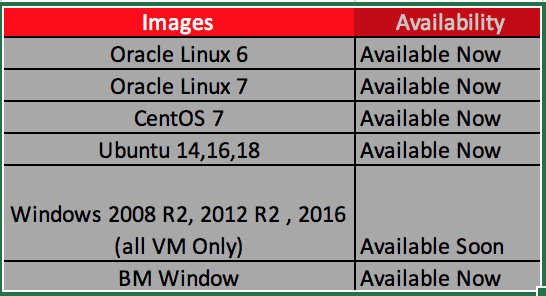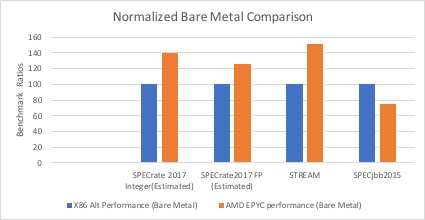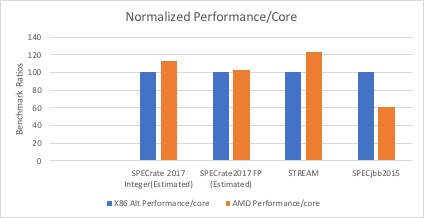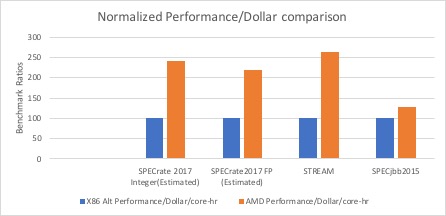As the world of computing continues to evolve, you require a diverse set of hardware and software tools to tackle your workloads in the cloud. With this in mind, I am excited to share that today, at Oracle OpenWorld 2018, we announced a collaboration with AMD to provide a new “E” series of compute instances on Oracle Cloud Infrastructure. The “E” series compute instances, showcase the higher core count, memory bandwidth, I/O bandwidth, advanced security features, and value of AMD EPYC processors.
Today, we are announcing the general availability of “Compute Standard E2 platform” which is the first addition to the E series. The Compute Standard E2 platform will be available in both Bare Metal and also 1 core, 2 core, 4 core and 8 core VM shapes. With the launch of Compute Standard E2 instances, Oracle Cloud Infrastructure becomes the first public cloud to have a generally available AMD EPYC processor-based compute instance. With 64 cores per server, Oracle has the largest core count instance available in production in the public cloud. With 33 percent more memory channels than comparable x86 instances, this new instance provides more than 269 Gb/s memory bandwidth, the highest recorded by any instance in the public cloud. Additionally, AMD EPYC processors are not affected by Meltdown and Foreshadow security vulnerabilities.
You get all of this for $0.03 per core hour, which is 66 percent less than general purpose instances offered by other clouds, 53 percent lower than Oracle’s other compute instances, and is the lowest price offered by any non-burstable compute instance in the public cloud.
Initial capacity is available in the Ashburn (IAD) region, expanding to other regions soon, for bare metal compute instances and 1-, 2-, 4-, and 8-core VM compute instances. The 16- and 24-core shapes will be offered in the first half of 2019, as shown in the following table.

Launching these instances through the Oracle Cloud Infrastructure Console or by using tools such as Terraform is the same as launching other x86 instances on Oracle Cloud Infrastructure. At launch, all of the images except the Windows VM image are available.

Key Use Cases
- AMD EPYC-based instances are ideal for general-purpose workloads where you want to maximize price performance. On low-level CPU benchmarks, namely SPEC_int and SPEC_FP, the AMD instance performs on par with the comparable x86 instance, at a lower cost.
- Oracle applications, including E-Business Suite, JD Edwards, and PeopleSoft, are supported on any Oracle Cloud Infrastructure x86 compute instances of appropriate size, including AMD EPYC-based instances.
- AMD EPYC-based instances are ideally suited for Big Data analytics workloads that rely on higher core counts and are hungry for memory bandwidth. AMD has a partnership with, and is certified to run software from, leading ISVs who are a part of the Hadoop ecosystem, including Cloudera, Hortonworks, MapR, and Transwarp. On a 10-TB full TeraSort benchmark, including TeraGen, TeraSort and TeraValidate, the AMD system demonstrated a 40 percent reduction in cost per OCPU compared to the other x86 alternatives with only a very slight increase in run times.
- AMD EPYC-based instances are also ideally suited to certain high-performance computing (HPC) workloads that rely on memory bandwidth, like computational fluid dynamics (CFD). On a 4-node, 14M cell Fluent CFD simulation of an aircraft wing, the AMD EPYC-based instance demonstrated a 30 percent reduction in cost along with a slight reduction in overall run times as compared to an x86 alternative.
Performance Numbers
We compared the AMD EPYC-based instances to our current x86 standard alternatives. The following table shows detailed configurations.
|
|
AMD EPYC System |
x86 Alternative System |
| CPU |
2 x AMD 7551, 32 cores per Socket @ 2.0 GHz |
2 x86 processor, 26 cores per Socket @ 2.0 GHz |
| Memory |
512 GB DDR4 |
786 GB DDR4 |
| Network |
2 x 25 Gbps |
2 x 25 Gbps |
We ran performance tests to exercise the CPU performance, memory subsystem performance, floating point compute power, and performance of server-side Java with emphasis on the middle tier. All of the tests were run on vendor-recommended proprietary compilers. The tests were run a number of times, and the results were averaged.
| Tests |
Benchmark Target |
| SPECrate 2017 Integer |
Integer performance |
| SPECrate 2017 Floating Point |
Floating point performance |
| STREAM |
Memory subsystem performance |
| SPECjbb2015 |
Middle tier performance |
The following graphs show how the AMD system compared against the x86 alternative. Figure 1 shows a normalized bare-metal-to-bare-metal comparison at the system level. Figure 2 shows a normalized performance-per-core comparison. Figure 3 shows a normalized performance-per-dollar-per-core comparison. The AMD system fared well in basic CPU and memory benchmarks, which can be attributed to the increased number of cores and the higher number of memory channels in the AMD system.
Figure 1: Bare Metal Comparison of AMD EPYC and x86 Standard SystemFigure 2:

Figure 2: Performance/Core Comparison of AMD EPYC and x86 Standard System

Figure 3: Performance/Dollar/Core Hour Comparison of AMD EPYC and x86 Standard System

At Oracle OpenWorld on October 24 in Moscone South, Room 154, from 12:30–1:15 p.m., we’ll be presenting a session with AMD about these new compute instances. We’ll also be showcasing AMD EPYC-based compute instances at SC18 in Dallas on November 12–15.
Thanks to the Compute team, our friends at OHD, and the rest of the Oracle Cloud Infrastructure team that worked day and night to launch the AMD EPYC offering.
If you have any questions, feel free to reach out.
Rajan Panchapakesan
Principal PM, Compute and HPC